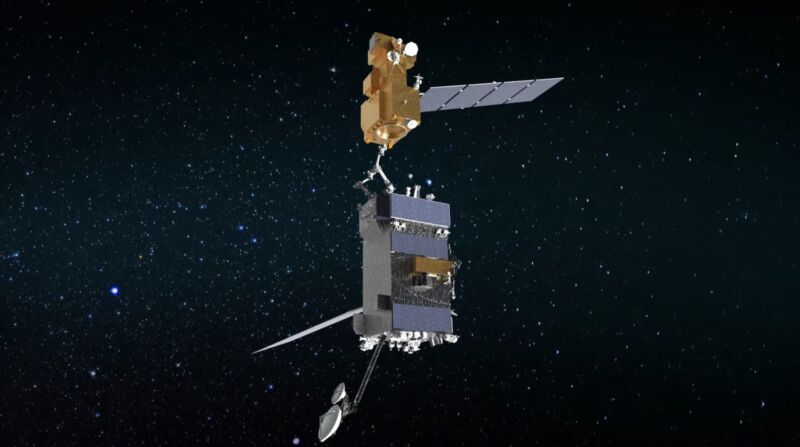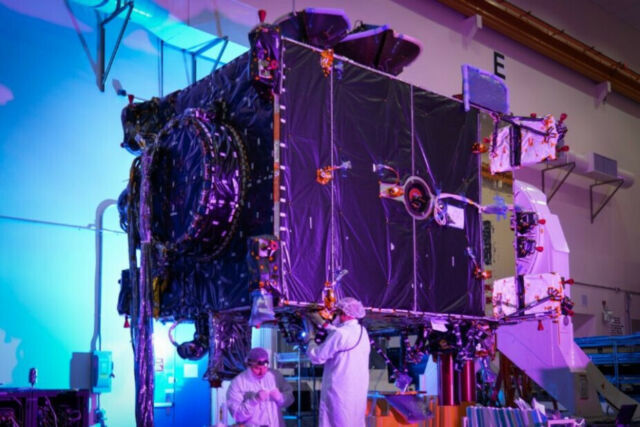In a brief statement March 1, NASA announced it was ending the On-Orbit Servicing, Assembly and Manufacturing (OSAM) 1 mission. OSAM-1 was being developed to refuel the Landsat 7 spacecraft and then perform the in-orbit assembly of a Ka-band satellite antenna.
NASA said it was canceling OSAM-1 “due to continued technical, cost, and schedule challenges, and a broader community evolution away from refueling unprepared spacecraft, which has led to a lack of a committed partner.”
- The agency said that, after formal congressional notifications of its decision, it would start the process for an orderly shutdown, which would include transferring hardware and “pursuing potential partnerships or alternative hardware uses.”
- NASA spokesperson Jimi Russell said there are approximately 450 NASA employees and contractors working on OSAM-1, and that NASA “is committed to supporting project workforce per plan through fiscal year 2024.”
Congress kept throwing money at the OSAM-1 mission, but it faced continual delays.
STEPHEN CLARK - 3/4/2024, 4:26 PM

Enlarge / Artist's illustration of the OSAM-1 spacecraft (bottom) linking up with the Landsat 7 satellite (top) in orbit.
NASA54
NASA has canceled an over-budget, behind-schedule mission to demonstrate robotic satellite servicing technology in orbit, pulling the plug on a project that has cost $1.5 billion and probably would have cost nearly $1 billion more to get to the launch pad.
The On-orbit Servicing, Assembly, and Manufacturing 1 mission, known as OSAM-1, would have grappled an aging Landsat satellite in orbit and attempted to refuel it, while also demonstrating how a robotic arm could construct an antenna in space. The spacecraft for the OSAM-1 mission is partially built, but NASA announced Friday that officials decided to cancel the project "following an in-depth, independent project review."
The space agency cited "continued technical, cost, and schedule challenges" for the decision to cancel OSAM-1.
Mission creep
The mission's cost has ballooned since NASA officially kicked off the project in 2016. The mission's original scope called for just the refueling demonstration, but in 2020, officials tacked on the in-orbit assembly objective. This involved adding a complex piece of equipment called the Space Infrastructure Dexterous Robot (SPIDER), essentially a 16-foot-long (5-meter) robotic arm to assemble seven structural elements into a single Ka-band communications antenna.
The addition of SPIDER meant the mission would launch with three robotic arms, including two appendages needed to grab onto the Landsat 7 satellite in orbit for the refueling demonstration. With this change in scope, the name of the mission changed from Restore-L to OSAM-1.
A report by NASA's inspector general last year outlined the mission's delays and cost overruns. Since 2016, the space agency has requested $808 million from Congress for Restore-L and OSAM-1. Lawmakers responded by giving NASA nearly $1.5 billion to fund the development of the mission, nearly double what NASA said it wanted.
Restore-L, and then OSAM-1, has always enjoyed support from Congress. The mission was managed by NASA's Goddard Space Flight Center in Maryland. Former Sen. Barbara Mikulski (D-Maryland) was a key backer of NASA missions run out of Goddard, including the James Webb Space Telescope. She was the top Democrat on the Senate Appropriations Committee when Congress started funding Restore-L in late 2015.
At one time, NASA projected the Restore-L mission would cost between $626 million and $753 million and could be ready for launch in the second half of 2020. That didn't happen, and the mission continued facing delays and cost increases. The most recent public schedule for OSAM-1 showed a launch date in 2026.
In 2020, after reshaping the Restore-L mission to become OSAM-1, NASA formally laid out a budget for the renamed mission. At the time, NASA said it would cost $1.78 billion to design, build, launch, and operate. An independent review board NASA established last year to examine the OSAM-1 mission estimated the total project could cost as much as $2.35 billion, according to Jimi Russell, a NASA spokesperson.
The realities of the satellite servicing market have also changed since 2016. There are several companies working on commercial satellite servicing technologies, and the satellite industry has shifted away from refueling unprepared spacecraft, as OSAM-1 would have demonstrated with the Landsat 7 Earth-imaging satellite.
Instead, companies are focusing more on extending satellite life in other ways. Northrop Grumman has developed the Mission Extension Vehicle, which can latch onto a satellite and provide maneuvering capability without cutting into the customer spacecraft to refuel it. Other companies are looking at satellites that are designed, from the start, with refueling ports. The US military has a desire to place fuel depots and tankers in orbit to regularly service its satellites, giving them the ability to continually maneuver and burn propellant without worrying about running out of fuel.

Enlarge / Maxar's spacecraft bus for the OSAM-1 mission.
Maxar
Maxar is NASA's prime contractor for the OSAM-1 mission, charged with supplying both the spacecraft platform and the robotic assembly payload. In a statement announcing the decision to cancel OSAM-1, NASA said the "broader community evolution away from refueling unprepared spacecraft" has "led to a lack of a committed partner" on the mission.
One of NASA's principles on the OSAM-1 project was to develop and prove out satellite servicing technologies, then hand them over to industry for commercial use. But many of the capabilities OSAM-1 would have demonstrated were no longer the ones that garnered interest in the commercial market.
"Technologies developed as part of OSAM-1 have been previously made available for commercial licensing and will continue to be available, albeit with no additional technology maturation or flight demonstration," Russell said in a statement to Ars.
Following the customary processes to notify Congress of its decision to cancel OSAM-1, NASA said it plans to "complete an orderly shutdown, including the disposition of sensitive hardware, pursuing potential partnerships or alternative hardware uses, and licensing of applicable technological developments."
Last year, Maxar delivered the main body of the OSAM-1 spacecraft from its factory in California to the Goddard Space Flight Center, where teams planned to install robotic arms and the modular Ka-band antenna the mission would have assembled in orbit. But this milestone was two-and-a-half years behind schedule, according to NASA's inspector general.
In its report, NASA's inspector general said much of the OSAM-1 mission's cost growth and delays "can be traced to Maxar's poor performance" on the spacecraft and SPIDER contracts.
"In our discussions with Maxar officials, they acknowledged that they were no longer profiting from their work on OSAM-1," the inspector general reported. "Moreover, project officials stated that OSAM-1 does not appear to be a high priority for Maxar in terms of the quality of its staffing."
The structure of NASA's firm fixed-price contracts with Maxar did not allow the agency to incentivize Maxar to improve its performance, according to the inspector general. In 2022 and 2023, NASA provided Maxar with labor valued at approximately $2 million to assist with flight software and systems engineering.
Maxar also delivered to NASA last year one of OSAM-1's robotic arms and a stowage platform that would secure the payloads to the satellite during launch. The final two robotic arms were on schedule for delivery this year, according to Eric Glass, a Maxar spokesperson.
"While we are disappointed by the decision to discontinue the program, we are committed to supporting NASA in pursuing potential new partnerships or alternative hardware uses as they complete the shutdown," Glass said. "We look forward to future opportunities to partner with NASA on innovative and pioneering technologies."
In a response to the inspector general's report last year, Maxar cited other factors causing OSAM-1 delays, including the COVID-19 pandemic and problems developing the NASA-led servicing payload that would actually refuel Landsat 7 in orbit. "Maxar Space Systems’ contracts represent only about 15 percent of the overall program budget," the company said.
NASA said it is reviewing how to mitigate the impact of OSAM-1's cancellation on the workforce at Goddard. Approximately 450 NASA employees and contractors are working on OSAM-1, according to Space News.
READER COMMENTS54




No comments:
Post a Comment